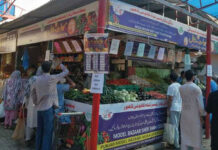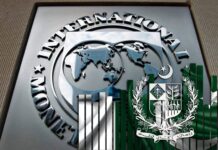In order to break the cycle of recurring instability and to put the economy on the path of sustained growth and stability, the government took some tough steps such as monetary tightening, exchange rate adjustment, expenditure control, enhancement of regulatory duties on non-essential imports and adjustment in energy prices which were kept subdued.
According to a statement issued by the Finance Division, the incumbent government made the decision of entering the IMF’s Extended Fund Facility ($6 billion) in order to support the balance of payments and strengthen the market confidence. Furthermore, it added, additional financial support from other development and bilateral partners would support the stability and ensure inclusive growth.
“The government is committed to introducing far-reaching reforms in every sector of the economy. The aspiration is to transform Pakistan into a land of opportunities. In this regard, a comprehensive overview of the initiatives announced by the government in different sectors of the economy during its first year is presented as under:
REAL SECTOR
The provisional GDP growth rate for FY19 remained 3.29pc mainly due to only 0.85pc growth in the agriculture sector, which was affected due to negative growth (-6.6pc) in important crops. The agriculture sector is the lifeline of Pakistan as it adds around 19pc to the economy, employs 38.5pc of labour force and remains a major source of raw material for several value-added sectors.
High performing agriculture sector is the centrepiece of the present government’s growth and poverty alleviation strategy. It has a very prominent role in achieving the goals of poverty alleviation and socio-economic uplift through inclusive growth of both farming and non-farming segments of the rural economy.
To improve agriculture sector and to make it in line with the economy’s requirement to achieve overall GDP growth, a National Agriculture Emergency Programme has been announced which intends to spend Rs280 billion on the sector in the next five years.
To boost jobs in the industrial sector, the government is providing incentives to the industrial sector through export development package, subsidies on electricity & gas as well as long-term trade financing.
The large-scale manufacturing sector, which posted negative growth in the outgoing year, is likely to rebound on the back of expected growth in agriculture sector coupled with government initiatives in the construction, SMEs, tourism and automobile sectors.
EXTERNAL SECTOR
The first critical challenge the government faced was the rapidly depleting foreign reserves. The main reason behind this was the SBP making continuous foreign exchange interventions. At first, SBP was stopped from making such interventions.
Further, the government also succeeded in mobilizing additional financing from friendly countries in the form of short- to medium-term loans, deferred payment on imported oil and temporary deposits in the central banks. These measures and inflows have strengthened Pakistan’s foreign exchange reserves and reduced external vulnerabilities.
Pakistan’s exports during FY2019 stood at $24.217 billion compared with $24.768 billion during FY18. The performance of exports in FY2019 has not been promising despite the number of export incentives. This may be due to the slow pace of global trade especially the trade war between US-China that has created uncertainty in trade flows.
The government has taken immediate actions to boost exports, including subsidized electricity and gas to industrial and export sectors, loans at low-interest rates, reduced import duties on raw materials of export-oriented industries, three-year extension in prime minister’s export package and duty-free access to 313 items secured from China.
Pakistan’s imports during FY19 stood at $ 52.436 billion compared with $56.592 billion FY18. The impact of stabilization efforts and imposition of regulatory duties on non-essential imports reflects in quantum effect which declined significantly and dominated the positive price effect.
Workers’ remittances surpassed the target of $21.2 billion in FY2019 and increased by 9.68pc to $21.841 billion as compared $19.913 billion in last year.
FISCAL SECTOR
The fiscal deficit was recorded at 5pc of GDP during July-March FY19. The government is committed to implementing structural reforms to narrow the fundamental revenue-expenditure gap. This will ensure an efficient and fair tax system with the ability to generate ample revenue to finance a large part of public expenditures.
On the revenue side, the fiscal strategy will focus on increasing revenue through broad-based tax policy and administration reforms to raise the tax to GDP ratio.
On the expenditure side, the government is following prudent expenditure consolidation. The government is making a strategy for cost recovery in energy and state-owned enterprises (SOEs). It will design new SOEs’ law aimed at modernizing and clearly defining the role of the state as owner, regulator, and shareholder of SOEs.
In this context, the recently established holding company to manage SOEs will follow the required governance and transparency principles in line with international best practices.
OTHER INITIATIVES
On the security front, there is no doubt that the situation in Pakistan has been improved significantly. According to the Overseas Investors Chamber of Commerce and Industry (OICCI), annual security survey conducted in June 2019 showed that foreign investors’ confidence in Pakistan’s security situation has increased by over 65pc.
British Airways has resumed flights to Pakistan after more than 10 years after a hotel bombing led to the suspension of the route. The airline is now scheduled to fly three times a week to Islamabad from London Heathrow on Boeing 787s.
The government is carrying out a vibrant foreign investment promotion policy, and has taken a number of economic liberalization measures to make the country more attractive. Pakistan offers a number of tax incentives for the establishment of industrial units in certain specific sectors; energy, ports, highways, electronics and software.
To attract FDI, the government is inclined toward setting up of special economic zones (SEZs). In this regard, Rashakai Economic Zone in Nowshera, Allama Iqbal Industrial City in Faisalabad, Dhabejji in Thatta, ICT Model Industrial Zone in Islamabad and Bostan Industrial Zone in Balochistan are prioritized under CPEC. The government is also keen to set up export-processing zones (EPZs) to encourage foreign investment. Some of the incentives offered to EPZ investors include exemptions from all federal, provincial and municipal taxes for export-destined production, exemptions from all taxes and duties on equipment, machinery and materials and access to EPZ’s “one window” services.
Pakistan’s ease of doing business index has improved up 11 points; this will surely attract foreign investors and will boost FDI. Furthermore, Pakistan carried out three reforms during the past year in the areas of starting a business, registering property and resolving insolvency that was recognized in the World Bank’s annual report titled “Ease of Doing Business 2019”.
The Board of Investment, with the help of relevant stakeholders, will keep on providing a conducive business environment and will make further efforts to improve ease of doing business in the country.























